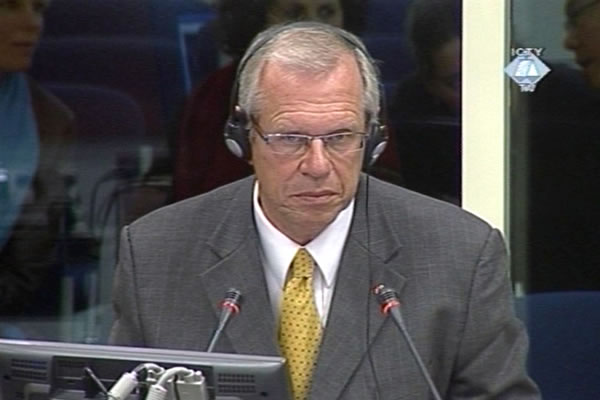Home
WHO SHELLED KNIN?
UN military observer testifying for the prosecution analyzed the craters of the six shells that hit a residential area. In his cross-examination, Ante Gotovina’s defense argued that those six shells were fired from positions held by the Serbian Army of Krajina in the afternoon of 5 August 1995, since by that time there were not many Serbs left in Knin
 Tor Munkelien, witness in the Gotovina trial
Tor Munkelien, witness in the Gotovina trial From 14 August to 1 December, Norwegian officer Tor Munkelien patrolled the so-called Sector South of the Knin Krajina as a UN military observer registering violations of human rights – killing of civilians, arson, destruction, looting of houses and killing of livestock – after Operation Storm. Everything he had seen and established during his patrolling was described by Munkelien in the two statements that were tendered into evidence, together with other UNMO documents from that period, today at the trial of Ante Gotovina, Ivan Cermak and Mladen Markac. The three Croatian generals are charged with crimes in the course of Operation Storm and its aftermath.
In his brief examination-in chief, Munkelien stated that the first thing he did upon his arrival to Knin was to analyze the craters left by the impact of six shells. He did this with his colleague Antil. The shells had hit a residential neighborhood some 350 to 500 meters away from the military barracks. He described how the military observers made the ‘preliminary estimate of damage’ caused by the shelling of Knin at the beginning of Operation Storm. They concluded that the shelling was concentrated on military targets. Civilian facilities were damaged only if they were located in the immediate proximity of military facilities. Parts of town with no military targets were hit only three to five times. In the view of the witness, the estimate was done ‘hastily’, under the pressure of the UNMO command who wanted an urgent report. That is why, he added, it turned out later that the shelling had caused more damage than was described in the preliminary report.
At the beginning of his cross-examination, Greg Kehoe, the defense counsel of the first-accused Ante Gotovina, challenged the witness’s expertise in analyzing craters and the impact of various artillery weapons noting that the witness had served in a medical unit of the Norwegian Army. According to the defense counsel, Munkelien misidentified the shells that had made the craters as M-63 shells. Kehoe contends they were M-77 shells, fired from multiple rocket launchers. Both M-63 and M-77 are used with multiple rocket launchers and have the same caliber, 122 mm, but M-77s are three times bigger than the M-63s and have stabilizers. On a photo of a shell, Kehoe pointed to bent metal pieces that, according to him, were parts of the shell’s stabilizer.
Kehoe didn’t contest all of the witness’s expertise. He accepted his estimate of the angle at which the shells fell and the direction from which they were fired. According to Kehoe, it showed that the shells were fired from Strmica area, where the SVK had its positions on 4 and 5 August 1995. Unlike the Croatian Army, the SVK used M-77 shells. Kehoe used a UN military observers' report of 5 August 1995 to corroborate this claim. The report states that until 18:05 hours, eight artillery weapons opened fire from the SVK positions in the direction of Knin. By then, there were few if any Serbs left in Knin. The witness replied that he was not aware of the report. He confirmed that he had no knowledge as to who fired the shells whose craters he had analyzed.
The cross-examination of Tor Munkelien continues tomorrow.
Linked Reports
- Case : Gotovina et al. - "Operation Storm"
- 2008-04-14 HOW MANY DEAD IN KNIN HOSPITAL?
- 2008-04-11 ‘ORGANIZED’ OR ‘ORDERLY’ MOVEMENT OF REFUGEES
- 2008-04-10 DEFENSE: CERMAK DID NOT ISSUE ORDERS – HE COORDINATED THINGS
- 2008-04-16 AUTHORITIES COULD HAVE PREVENTED ARSON AND LOOTING
- 2008-04-17 DEAD BODIES WERE RUN OVER BY TANKS
- 2008-04-22 ‘INDISCRIMINATE AND DELIBERATE’ SHELLING OF KNIN
